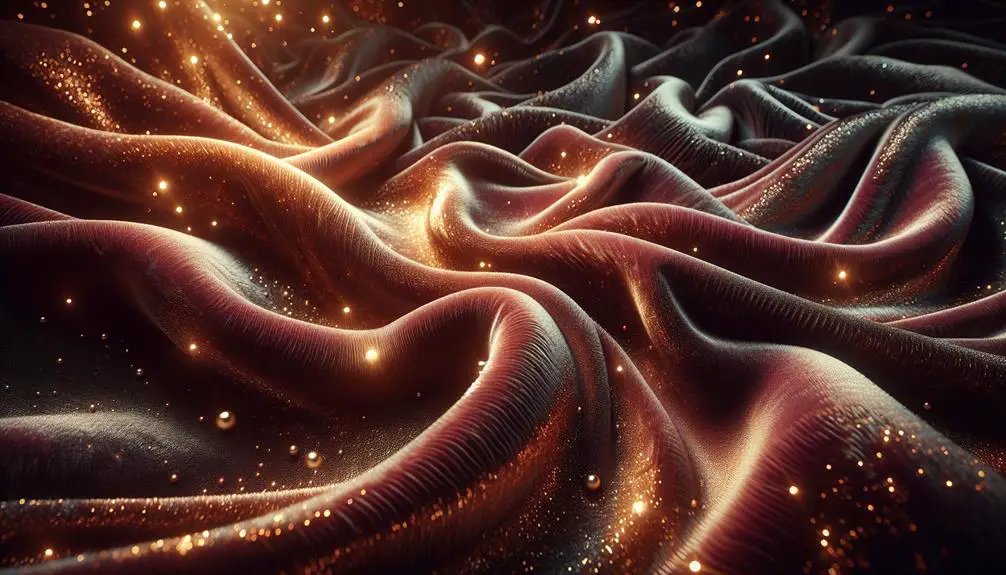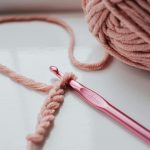Have you ever wondered why velvet has that distinctive, luscious shine? It all boils down to its structure and fiber type. The fabric's short, dense pile, combined with the way it's woven, allows it to catch light in a unique way. But there's more to it than just its physical attributes. The different fibers used in making velvet react uniquely with dyes, adding depth and richness to its appearance. Now, I'm curious to explore how these elements work together to give velvet its gleaming surface. There's a lot more going on than you might think.
Table of Contents
Key Takeaways
- Velvet's shine originates from its unique pile structure, where fibers are densely woven and evenly cut to reflect light uniformly.
- The fiber arrangement in velvet allows for optimal light reflection, enhancing its inherent glossiness.
- Different fibers like silk and polyester, used in velvet, react distinctively to light, contributing to its shiny appearance.
- Dyeing processes add to velvet's luster by deepening color absorption and altering how light is refracted off the fabric.
- High-density weaves in velvet increase its surface smoothness, which in turn, boosts light reflection and shine.
The History of Velvet
Velvet's opulent journey began in ancient Egypt, where it was first woven from silk and reserved for royalty and nobility. This fabric's origins are deeply intertwined with the elite, symbolizing power and wealth through its glossy finish and smooth texture. As I explore the history, it's clear why velvet has always held such prestigious status.
From Egypt, the knowledge of velvet production spread across the globe, finding a particularly strong foothold in medieval Europe. Cities like Venice and Genoa became centers for velvet manufacturing, perfecting the techniques and contributing to its allure among the upper classes. Kings and queens draped themselves in velvet robes, and it was often used in royal portraits to emphasize status and sophistication.
The royal associations of velvet aren't just about its appearance. The production process was incredibly labor-intensive and costly, making it inaccessible to the common folk. This exclusivity bolstered its status as a symbol of power and luxury.
Understanding velvet's past, especially its beginnings and connections with nobility, enhances our appreciation of this fabric. It's not just a material; it's a historical artifact that carries the weight of its regal legacy.
Understanding Velvet's Structure
Let's take a closer look at what makes velvet so unique.
First, we'll explore the different fibers used in velvet and how their composition affects the fabric's feel and shine.
Then, I'll explain the weaving techniques that give velvet its luxurious texture.
Velvet Fiber Composition
To understand why velvet appears so shiny, we must first examine its unique fiber composition. Velvet can be made from various fibers, including silk, cotton, and synthetics like polyester. Each of these materials contributes differently to the fabric's overall look and feel. Silk, for instance, naturally enhances the shine and provides a smooth texture, making it a popular choice for high-end velvet. The strength and fiber durability of synthetic materials like polyester allow for frequent use and easier maintenance.
Moreover, chemical treatments are often applied to enhance the fabric's characteristics, including its lustrous appearance. These treatments can also improve resistance to stains and water, making velvet not just beautiful but also more durable and practical for everyday use.
Weaving Techniques Explained
Now, we'll explore how velvet is woven, a key factor in its plush, luxurious texture.
The process starts on specialized loom types—either a double cloth loom or a pile weave loom. Both are essential for creating velvet's signature texture.
Here's the scoop: these looms handle thread tension with precision, critical for forming the short, dense pile that makes velvet stand out.
The looms interlace two layers of fabric simultaneously, with threads tightly controlled to avoid any slippage.
Types of Fibers Used in Velvet
Velvet can be made from a variety of fibers, including silk, cotton, and synthetic materials like polyester. Each type of fiber brings its own set of characteristics to the fabric, significantly affecting its durability and how it holds color. When discussing fiber durability, it's important to understand that the longevity of velvet heavily depends on the type of fiber used. Silk velvet, for example, is renowned for its softness and deep color absorption, but it's not as robust as synthetic velvets. Polyester, on the other hand, offers incredible resilience and is less prone to wear and tear—it's a go-to for furniture upholstery for this reason.
Now, let's talk about colorfastness testing. This is a must when evaluating velvet, especially since this fabric often comes in rich, deep hues. Colorfastness testing ensures that the color of the velvet won't easily fade or bleed during cleaning or with exposure to light. Silk might score slightly lower here compared to synthetics, which generally hold dyes better and resist fading more robustly. Cotton velvet strikes a balance, offering moderate durability and color retention, making it a versatile choice for both clothing and furnishings.
The Role of Weave Density
Now, let's talk about how the density of the weave in velvet affects its shine.
We'll start by explaining what weave density actually means, then we'll see how it plays a pivotal role in how light reflects off the fabric.
Comparing fabrics with low and high density will really show us why some velvet looks more luxurious than others.
Weave Density Explained
Understanding weave density is essential to explaining why velvet has such a distinctive shine. It's all about how tightly the threads are packed together. A higher thread count means more threads per square inch, and this density is vital.
It's not just about quantity, though; the quality of these threads matters too. Fiber elasticity properties play a significant part. Fabrics with elastic fibers, like some velvets, can bounce back to their original shape more easily, maintaining a tight weave even under stress.
This tight, resilient weave impacts how the fabric interacts with light, although we're not diving into light reflection here. Just know that without this dense, elastic weave, velvet wouldn't have its signature luxe and luster.
Impact on Light Reflection
Let's explore how the dense weave of velvet affects its interaction with light, giving it a unique shine. The importance of the weave plays a pivotal role in light absorption and surface smoothness. Fundamentally, when light hits the surface of velvet, the densely packed fibers increase the material's ability to absorb light. This absorption minimizes the light that bounces back, which is why darker velvets appear so rich and deep.
However, the parts of the light that aren't absorbed get reflected unevenly due to the plushness of the surface. This uneven reflection contributes to velvet's characteristic lustrous sheen. So, the density isn't just about aesthetics; it fundamentally alters how velvet interacts with light, enhancing its intrinsic glow.
Comparing Low-High Density Weaves
The density of a velvet weave greatly influences its shine and texture. When I compare low-density to high-density velvet, the differences are stark. High-density weaves pack more fibers per inch, which amplifies the fabric's inherent glossiness. This higher concentration of fibers reflects light more uniformly, giving the surface a more pronounced shine.
On the other hand, low-density velvet, with fewer fibers, tends to have less uniform light reflection, which results in a subtler glow and more pronounced texture variations. It's fascinating how simply altering weave density can transform the entire look and feel of the fabric.
For anyone keen on fabric design or manufacturing, understanding this relationship between fiber density and visual effects is essential to mastering velvet's luxurious appeal.
Pile Direction and Light Reflection
Velvet's unique shine largely comes from how its fibers are arranged, affecting the way light bounces off the surface. When you look at velvet, you're not just seeing a fabric; you're witnessing a complex interplay of light due to the direction of the pile. The pile is the term used for the short fibers that stand up on the fabric, and these are essential for that signature velvet gloss.
What's fascinating is how the cutting techniques used during manufacturing affect the surface texture of velvet. This directly influences how shiny the fabric appears. If the pile is cut uniformly and at the right angle, it reflects light more intensely. However, if the pile is uneven or cut at a less ideal angle, the shine can be subdued.
| Emotion | Light Intensity | Velvet Texture |
|---|---|---|
| Warmth | High | Smooth |
| Mystery | Medium | Lustrous |
| Elegance | Low | Rich |
This table evokes the feelings associated with different levels of shine and texture in velvet. Each combination creates a unique sensory experience, enhancing our emotional connection to the fabric. It's not just cloth; it's an art form that plays with light and texture to stir our feelings.
Impact of Dye and Color
Dyeing velvet often dramatically alters its appearance, enhancing both its color depth and luminosity. When we look at how color chemistry and dye methods impact velvet, we're diving deep into a fascinating aspect of textile science. Different dyes interact with velvet's unique structure in ways that can amplify its natural sheen.
Here's how it works:
- Fiber Absorption: Velvet can be made from various fibers, each reacting distinctly to dyes. Silk and rayon, for example, are highly absorbent, which means they take up dye deeply and evenly, resulting in rich, vibrant colors that seem to glow from within.
- Color Layering: Applying multiple dye layers can create a complex interplay of shades and tones in velvet. This layering can enhance the way light interacts with the fabric, giving it a multi-dimensional sheen that's quite striking.
- Reflection and Refraction: The plush pile of velvet naturally reflects light, but when dyed, the color particles in the dye can change the way light is refracted within the fibers. This can make the velvet appear even shinier.
Understanding these elements isn't just about figuring out why velvet looks the way it does; it's about mastering the art of fabric manipulation to achieve specific aesthetic goals.
Comparing Velvet to Other Fabrics
Let's compare velvet to other fabrics to highlight its unique characteristics and appeal. Velvet's luxurious sheen and depth of color set it apart instantly. But let's dig deeper into fabric durability and cost comparison to really understand its value.
Velvet, traditionally made from silk, provides a soft yet dense pile which is less durable than some other fabrics like denim or canvas. This means it mightn't be the best choice for items that require high durability like everyday wear or furniture that faces heavy use. However, synthetic velvets offer increased durability and are often more resistant to wear and tear, making them a more practical choice for frequent use.
When it comes to cost, velvet generally ranks higher on the price scale compared to fabrics like cotton or polyester. The production process of velvet, especially silk velvet, is more labor-intensive, which contributes to its higher cost. But consider this: the elegance and the feel of velvet often justify the expense, particularly for special occasions or luxury decor.
In comparing velvet to other textiles, it's clear that while it may not be the most durable, its aesthetic appeal and luxurious feel provide a unique value that might be worth the extra investment.
Care and Maintenance Tips
Now, let's talk about how to keep your velvet looking great.
I'll cover the essentials: how to wash it, store it, and handle it.
These tips will help you maintain that luxurious shine and feel.
Washing Velvet Properly
To maintain your velvet looking its best, it's crucial to wash it correctly. Here's how I ensure my velvet garments stay stunning:
- Detergent Selection: Always opt for a mild detergent. Harsh chemicals can damage the fibers, dulling that signature sheen we all love.
- Washing Technique: Hand wash or use a gentle cycle with cold water. Velvet's delicate nature means it doesn't take well to rough handling or hot temperatures.
- Drying Methods: Never wring out velvet. Instead, lay it flat on a towel to air dry. This prevents the fibers from becoming misshapen and keeps the texture intact.
Storing Velvet Correctly
Storing velvet correctly is essential for keeping it in pristine condition. When it comes to velvet preservation, understanding the climate impact is vital. You don't want excess humidity or dryness affecting your fabric. Here's a quick guide I put together to help you store your velvet the right way.
| Do | Don't |
|---|---|
| Store in a cool, dry place | Expose to direct sunlight |
| Use padded hangers for hanging | Fold tightly, as it causes creases |
| Cover with a breathable cloth | Use plastic covers, traps moisture |
| Maintain moderate humidity | Let it get too humid or too dry |
Handling Velvet Gently
Handling velvet gently is essential to maintain its luxurious feel and appearance. Here's how I make sure my velvet stays pristine:
- Avoid Water: Velvet's durability can suffer if it gets too wet. For small stains, I use specific velvet cleaning methods, spotting with a dry cloth and a bit of cleaning solvent rather than water.
- Smooth, Don't Rub: When tackling dust or dirt, I always opt to gently pat or shake the fabric instead of rubbing it. This keeps the pile undisturbed and shiny.
- Proper Tools: I invest in a soft-bristled brush. Brushing with the nap, not against it, helps maintain the texture and sheen.
Technological Advances in Velvet Production
Advancements in technology have greatly streamlined the production process of velvet, making it both faster and more cost-effective. One of the most exciting fabric innovations I've come across is the integration of automated weaving looms. These machines haven't only sped up the manufacturing process but have also notably enhanced the consistency of velvet's plush texture. It's fascinating to see how precision engineering can result in such a luxurious finish.
Another key area where technology has made a huge impact is in production sustainability. Manufacturers are now adopting eco-friendly practices that minimize waste and reduce water usage. This shift is important because traditional velvet production can be quite resource-intensive. By implementing closed-loop systems and using sustainable dyes, the industry is becoming more environmentally responsible without compromising the fabric's quality.
As a fabric enthusiast, I'm thrilled to see these technological advances not just improving efficiency but also making velvet more accessible. It's a win-win situation—better quality fabric at lower costs and with less environmental impact. The next time you touch that soft, shimmering velvet, remember there's a lot of innovative technology behind its production.
Velvet in Fashion and Design
While we've seen how technology has revolutionized velvet production, it's also reshaping its role in fashion and design. As someone who keeps an eye on velvet trends, I've noticed a few key shifts that are worth highlighting:
- Runway Revival: Velvet has made a big comeback on fashion runways. Designers are experimenting with bold colors and unexpected silhouettes, making velvet garments a staple for both high-end fashion and street style. This isn't just about traditional gowns; we're seeing velvet in everything from suits to casual wear, proving its design versatility.
- Home Decor: Beyond clothing, velvet's rich texture and depth are enhancing interior design. From plush velvet sofas to curtains, designers are leveraging its luxurious feel to add a touch of elegance and comfort to living spaces. It's becoming a popular choice for statement pieces that draw the eye and create a warm, inviting atmosphere.
- Accessories: Velvet isn't limited to large pieces. It's also popping up in accessories like bags, shoes, and hats. These pieces often use velvet to add a sophisticated or vintage touch, showcasing how versatile the material is beyond traditional uses.
The evolving applications of velvet in fashion and design reflect its enduring appeal and adaptability.
Frequently Asked Questions
How Does Humidity Affect Velvet's Appearance and Texture?
I've noticed that humidity affects velvet by increasing its fabric absorption and moisture retention, making it feel heavier and less smooth. This change can also alter its usual sleek appearance.
Can Velvet Trigger Allergies in Sensitive Individuals?
Yes, velvet can trigger allergies, especially due to its fabric composition. I'd recommend allergy testing if you're sensitive. Understanding the materials in velvet helps gauge if it's a potential irritant for you.
What Are the Environmental Impacts of Producing Velvet?
Creating velvet has a notable effect on the environment, particularly in water usage and chemical pollutants. I've learned it's crucial to take into account these factors when evaluating the sustainability of fabrics.
How Does Velvet React to Different Lighting Conditions?
Velvet's unique because of how it reacts to light. It reflects light variably, causing rich color shifts. I've noticed it looks different depending on the angle and intensity of the light hitting it.
Is Velvet Considered a Sustainable Fabric Choice?
Velvet's not typically seen as sustainable due to its production methods and the materials often used. However, recycling velvet can improve its sustainability, making it a better choice for environmentally conscious consumers.
- How Does Ring Spun Cotton Affect Garment Fit and Shape Retention? - August 13, 2024
- What Are the Challenges in Producing Ring Spun Cotton? - August 13, 2024
- Is Ring Spun Cotton Suitable for Plus-Size Clothing? - August 13, 2024






